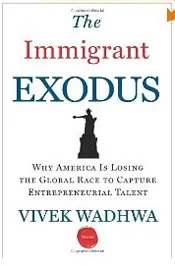[Book Review] The Immigrant Exodus: Why America Is Losing the Global Race to Capture Entrepreneurial Talent

by Vivek Wadhwa2012 Wharton Digital Press (Amazon)
6 chapters; 106 pages
Backed by lots of data and research, tech analyst Vivek Wadhwa charts the rise and decline of the immigrant-powered startup machine in the US, explains the dilemmas immigrant entrepreneurs now face in the US, describes how other countries are attracting expats and immigrants, and recommends fixes in the US visa approach.
This impassioned and provocative publication is a must-read not just for US citizens but also those in other countries who want to create and nurture their own Silicon Valleys and tech hubs, and tap into global flows of entrepreneurial talent (eg. see my book review of Cloning Silicon Valley).
Wadhwa draws on the earlier research of regional economics scholar Annalee Saxenian (see my 1998 interview with her). Saxenian has chronicled the rise of immigrant communities and innovation networks in Silicon Valley startups in the 1990s, and Wadhwa teamed up with her to extend this research across the country.
Unfortunately, the focus of the US government seems to be less on fixing the immigration policy for entrepreneurs and more on bailing out big banks or ‘funding distant wars of dubious value to the tune of trillions of dollars,’ Wadhwa laments. Besides, immigrant entrepreneurs cannot vote on policy and do not engage in expensive lobbying and politicking.
Interested readers can download excellent research papers on these topics from the Kaufmann Foundation and Social Science Research Network. There are also authors with a different approach to fixing the talent crisis, eg. reforming the US education system (see my book review of Tony Wagner's Creating Innovators.)
Wadhwa personally interviews a range of entrepreneurs from India, China, Chile and other countries to uncover the human face of entrepreneur stories. His own background as an immigrant entrepreneur lends extra empathy and depth to these profiles: Anand Chhatpar (India: founder of BrainReactions, Fame Express), Jason Gang Jin (China: Shanghai BioChip), Sophie Vandebroek (Belgium: head of Xerox research labs worldwide), James Liang (China: Ctrip e-travel), Mayel de Borniol (Chile: Babelverse) and Punit Gupta (India: PriceCheck).
“The American Dream I knew is losing its lustre. Restrictive US immigration policies and the rise of other countries’ economies are driving talent elsewhere,” Wadhwa begins.
A number of US authors such as Thomas Friedman have already described how the world is becoming increasingly inter-connected and entrepreneurial, and the US is gaining in some ways (eg. new markets and offshore support) but losing out in other ways (eg. competition from players in emerging economies). The US is in danger of losing current and future ‘brain capital’ if it does not win the talent race, according to a range of industry leaders.
Many ‘developing countries’ were recovering from the effects of colonisation and ineffective governance in the last century, driving waves of skilled techies and aspiring students to the US. But now entrepreneurial opportunities abound in countries like China and India: many of their students do not go abroad, and immigrant entrepreneurs in the US are returning to their home countries. The US is no longer the only ‘beacon of hope’ for international talent, and the US itself has ‘tied one hand behind its back’ with a broken immigration policy, according to Wadhwa.
Vivek Wadhwa himself came to the US at age six (his father was posted to the Indian consulate) and then moved to Australia where he graduated in computer science from the University of Canberra. He then moved back to the US to work in large firms (Xerox, First Boston) and head startups (Seer Technologies, Relativity Technologies).
He is currently director of research at the Center for Entrepreneurship and Research Commercialisation and executive in residence at the Pratt School of Engineering, Duke University. He is also vice president of innovation and strategy at Singularity University, and fellow at Stanford University and Emory University. Wadhwa is a regular columnist for the Washington Post, Bloomberg BusinessWeek, and Forbes.com. In February 2012, the US government awarded Wadhwa distinguished recognition as an “Outstanding American by Choice.”
Many of America’s greatest entrepreneurs and business leaders over the centuries were first- or second-generation immigrants: Andrew Carnegie (Carnegie Steel Company), Alexander Graham Bell (AT&T), Charles Pfizer (Pfizer), Vinod Khosla (Sun Microsystems), Sergey Brin (Google), and Elon Musk (PayPal).
“Those of us who grew up in other countries and cultures can see and appreciate the power of those unique American values perhaps better than Americans themselves. We are energised by the freedom of opportunity, the dynamic business culture, and the excellent schools of higher learning. We are motivated to use that energy and learning to better ourselves in this land of opportunity, and in the process to contribute to America’s success,” according to Alcoa CEO Klaus Kleinfeld, a German citizen living in the US, who wrote this in an email to Wadhwa.
Immigrants were responsible for more than one in every four (28%) US businesses founded in 2011, significantly outpacing their share of the population (12.9%). “Thus, net new job creation — the most important economic driver of the US economy — has become inextricably linked to and dependent upon immigration and the skills of immigrants,” Wadhwa explains.
The number of international patent applications filed by non-citizen immigrants increased from 7.3% in 1998 to 24.2% in 2006. These were led by nationals from China, India, Canada and Britain. Foreign-born inventors are particularly active in semiconductor device manufacturing, IT, digital communications and pharmaceuticals.
Indian immigrants began to outpace their Chinese counterparts as founders of engineering and technology companies in Silicon Valley. 25.3% of all engineering and technology companies established in the US between 1995 and 2005 had at least one immigrant founder.
Unfortunately for the US, the immigrant entrepreneur tide peaked and reversed in recent years, with growing stories of frustration about ‘visa hell’ – not getting visas and green cards. Delay in getting green cards leads to stress for the immigrants and takes away from their ability to immerse in their host communities; many immigrants have also been denied green cards even though they had launched successful companies.
The proportion of immigrant-founded companies in the US has begun to slide. “The juggernaut of immigrant entrepreneurship in tech and engineering companies has reversed course. The US risks losing a key growth engine right at the moment when its economy is stuck in a deep ditch, growing slowly and struggling to create jobs,” Wadhwa laments.
“America’s loss has been the gain of countries such as India, China, and Korea,” he adds. Returning immigrants in the reverse brain drain are sometimes called ‘sea turtles’ in China. Immigrants are returning to their countries due to improving local innovation ecosystems, better career opportunities, government incentives, family ties, quality of life, and professional growth.
For example, 30% of IITians who graduated from 1964 to 2001 moved to the US (I myself was one of them, and then returned to India in 1996); that number declined to 9% from 2002 through 2008. Entrepreneurs in India such as Sachin and Binny Bansal, graduates from IIT-Delhi, have found local success (e-commerce site FlipKart) without needing to go abroad.
Globally, bigger trends which cause concern for the US are the fact that only 4% of the world’s undergraduate engineering degrees go to US citizens; 56% are earned in Asia, and 17% in Europe. The combined natural sciences and engineering degrees awarded in South Korea, Taiwan, and Japan exceed the combined degree tally for the US.
One fascinating chapter (though too brief) covers how other countries are launching their own initiatives to retain their entrepreneurs and attract outside talent. I have summarised some of these practices in Table 1 below; the chapter invites further research and comparisons between the innovation ecosystems and immigration policies of other countries.
Table 1: Policies to Attract Entrepreneurs
Some of the companies featured in Startup Chile include Maptia (online mapping), Andean Designs (Andean ceramics) and Biometry Cloud (pattern recognition). The programme is clearly trying to attract maverick thinkers and tinkerers the way Silicon Valley did.
“India does not have a strategy to attract talented people -- it does not need it. It offers an exploding market and a culture that its people want to return to,” according to Wadhwa. But I am sure the non-Indian business and entrepreneur community in India would argue that much more could be done by the Indian government to make life more hassle-free for them; Indian startups and VCs too would argue for easier registration procedures and investment-friendly policies.
One chapter covers immigration legislation in the US. The racist policies of the early 1900s (such as the Johnson-Reed Act and Asian Exclusion Act) were subsequently overturned. The Hart-Celler Act expanded entry quotas significantly in the 1960s.
To avoid a situation of reducing ‘first-class minds to second-class citizens,’ Wadhwa recommends that the US increase the number of green cards for skilled immigrants, allow spouses of H-1B visa holders to work, target immigration based on required skills (eg. mobile phone developers), untether the H-1B worker from the employer, allow foreign students to work for four years (instead of just one year), institute a startup visa, and remove the country caps on green cards.
Wadhwa also explains that some of his proposals have come under attack as a front for abuse by body-shopping companies and exploitation of cheap labour. There have been reported cases of fraud as well, but these are relatively small in proportion and should not detract from the big picture.
“Even though the US is facing many problems when it comes to attracting and retaining skilled immigrants, the US remains the most entrepreneurial, technologically advanced society on earth. How long the US can hold onto this leading role is, for the first time, a subject of open debate,” concludes Wadhwa.
[Follow YourStory's research director Madanmohan Rao on Twitter]






![[Book Review] The Immigrant Exodus: Why America Is Losing the Global Race to Capture Entrepreneurial Talent](https://images.yourstory.com/cs/wordpress/2012/10/immigrant_exodus.jpg?mode=crop&crop=faces&ar=2:1?width=3840&q=75)




